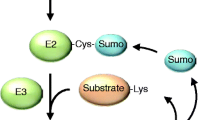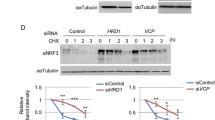Abstract
We have previously shown that UEV1 is up-regulated in all tumor cell lines examined and when SV40-transformed human embryonic kidney cells undergo immortalization; however, it is unclear whether and how UEV1 plays a critical role in this process. UEV1A encodes a ubiquitin conjugating enzyme variant, which is required for Ubc13 (ubiquitin conjugating enzyme) catalyzed poly-ubiquitination of target proteins through Lys63-linked chains. One of the target proteins is NEMO/IKKγ (nuclear factor-κB essential modulator/inhibitor of κB protein kinase), a regulatory subunit of IκB kinase in the NF-κB signaling pathway. In this report, we show that constitutive high-level expression of UEV1A alone in cultured human cells was sufficient to cause a significant increase in NF-κB activity as well as the expression of its target anti-apoptotic protein, Bcl-2 (B-cell leukemia/lymphoma 2). Overexpression of UEV1A also conferred prolonged cell survival under serum-deprived conditions, and protected cells against apoptosis induced by diverse stressing agents. All of the effects of Uev1A were reversible upon suppression of UEV1 expression by RNA interference. Our observations presented in this report provide evidence that Uev1A is a critical regulatory component in the NF-κB signaling pathway in response to environmental stresses and identify UEV1A as a potential proto-oncogene.
Similar content being viewed by others
References
Rothofsky ML, Lin SL (1997) CROC-1 encodes a protein which mediates transcriptional activation of the human FOS promoter. Gene 195:141–49
Sancho E, Vila MR, Sanchez-Pulido L et al (1998) Role of UEV-1, an inactive variant of the E2 ubiquitin-conjugating enzymes, in in vitro differentiation and cell cycle behavior of HT-29-M6 intestinal mucosecretory cells. Mol Cell Biol 18:576–89
Ma L, Broomfield S, Lavery C et al (1998) Up-regulation of CIR1/CROC1 expression upon cell immortalization and in tumor-derived human cell lines. Oncogene 17:1321–326
Broomfield S, Chow BL, Xiao W (1998) MMS2, encoding a ubiquitin-conjugating-enzyme-like protein, is a member of the yeast error-free postreplication repair pathway. Proc Natl Acad Sci USA 95:5678–683
Xiao W, Lin SL, Broomfield S, Chow BL, Wei YF (1998) The products of the yeast MMS2 and two human homologs (hMMS2 and CROC-1) define a structurally and functionally conserved Ubc-like protein family. Nucleic Acids Res 26:3908–914
Kallioniemi A, Kallioniemi OP, Piper J et al (1994) Detection and mapping of amplified DNA sequences in breast cancer by comparative genomic hybridization. Proc Natl Acad Sci USA 91:2156–160
Tanner MM, Tirkkonen M, Kallioniemi A et al (1994) Increased copy number at 20q13 in breast cancer: defining the critical region and exclusion of candidate genes. Cancer Res 54:4257–260
Tanner MM, Tirkkonen M, Kallioniemi A et al (1995) Amplification of chromosomal region 20q13 in invasive breast cancer: prognostic implications. Clin Cancer Res 1:1455–461
Brinkmann U, Gallo M, Polymeropoulos MH, Pastan I (1996) The human CAS (cellular apoptosis susceptibility) gene mapping on chromosome 20q13 is amplified in BT474 breast cancer cells and part of aberrant chromosomes in breast and colon cancer cell lines. Genome Res 6:187–94
El-Rifai W, Harper JC, Cummings OW et al (1998) Consistent genetic alterations in xenografts of proximal stomach and gastro-esophageal junction adenocarcinomas. Cancer Res 58:34–7
Savelieva E, Belair CD, Newton MA et al (1997) 20q gain associates with immortalization: 20q13.2 amplification correlates with genome instability in human papillomavirus 16 E7 transformed human uroepithelial cells. Oncogene 14:551–60
Yeager TR, DeVries S, Jarrard DF et al (1998) Overcoming cellular senescence in human cancer pathogenesis. Genes Dev 12:163–74
McKenna S, Spyracopoulos L, Moraes T et al (2001) Noncovalent interaction between ubiquitin and the human DNA repair protein Mms2 is required for Ubc13-mediated polyubiquitination. J Biol Chem 276:40120–0126
McKenna S, Moraes T, Pastushok L et al (2003) An NMR-based model of the ubiquitin-bound human ubiquitin conjugation complex Mms2.Ubc13. The structural basis for lysine 63 chain catalysis. J Biol Chem 278:13151–3158
Moraes TF, Edwards RA, McKenna S et al (2001) Crystal structure of the human ubiquitin conjugating enzyme complex, hMms2-hUbc13. Nat Struct Biol 8:669–73
Hofmann RM, Pickart CM (1999) Noncanonical MMS2-encoded ubiquitin-conjugating enzyme functions in assembly of novel polyubiquitin chains for DNA repair. Cell 96:645–53
Pickart CM (2001) Mechanisms underlying ubiquitination. Annu Rev Biochem 70:503–33
Deng L, Wang C, Spencer E et al (2000) Activation of the IκB kinase complex by TRAF6 requires a dimeric ubiquitin-conjugating enzyme complex and a unique polyubiquitin chain. Cell 103:351–61
Wang C, Deng L, Hong M et al (2001) TAK1 is a ubiquitin-dependent kinase of MKK and IKK. Nature 412:346–51
Shi CS, Kehrl JH (2003) Tumor necrosis factor (TNF)-induced germinal center kinase-related (GCKR) and stress-activated protein kinase (SAPK) activation depends upon the E2/E3 complex Ubc13-Uev1A/TNF receptor-associated factor 2 (TRAF2). J Biol Chem 278:15429–5434
Lin A, Karin M (2003) NF-κB in cancer: a marked target. Semin Cancer Biol 13:107–14
Hayden MS, Ghosh S (2004) Signaling to NF-κB. Genes Dev 18:2195–224
Zhou H, Wertz I, O’Rourke K et al (2004) Bcl10 activates the NF-κB pathway through ubiquitination of NEMO. Nature 427:167–71
Sun L, Deng L, Ea CK, Xia ZP, Chen ZJ (2004) The TRAF6 ubiquitin ligase and TAK1 kinase mediate IKK activation by BCL10 and MALT1 in T lymphocytes. Mol Cell 14:289–01
Ea CK, Deng L, Xia ZP, Pineda G, Chen ZJ (2006) Activation of IKK by TNFα requires site-specific ubiquitination of RIP1 and polyubiquitin binding by NEMO. Mol Cell 22:245–57
Debatin KM (2004) Apoptosis pathways in cancer and cancer therapy. Cancer Immunol Immunother 53:153–59
Azoitei N, Wirth T, Baumann B (2005) Activation of the IκB kinase complex is sufficient for neuronal differentiation of PC12 cells. J Neurochem 93:1487–501
Chen GG, Liang NC, Lee JF et al (2004) Over-expression of Bcl-2 against Pteris semipinnata L-induced apoptosis of human colon cancer cells via a NF-κB-related pathway. Apoptosis 9:619–27
Chen GG, Lee JF, Wang SH et al (2002) Apoptosis induced by activation of peroxisome-proliferator activated receptor-gamma is associated with Bcl-2 and NF-κB in human colon cancer. Life Sci 70:2631–646
O’Connell J, Bennett MW, Nally K et al (2000) Altered mechanisms of apoptosis in colon cancer: Fas resistance and counterattack in the tumor-immune conflict. Ann N Y Acad Sci 910:178–92
Ditsworth D, Zong WX (2004) NF-κB: Key mediator of inflammation-associated cancer. Cancer Biol Ther 3:1214–216
Pikarsky E, Porat RM, Stein I et al (2004) NF-κB functions as a tumour promoter in inflammation-associated cancer. Nature 431:461–66
Clevers H (2004) At the crossroads of inflammation and cancer. Cell 118:671–74
Karin M (2005) Inflammation and cancer: the long reach of Ras. Nat Med 11:20–1
Yu JY, DeRuiter SL, Turner DL (2002) RNA interference by expression of short-interfering RNAs and hairpin RNAs in mammalian cells. Proc Natl Acad Sci USA 99:6047–052
Andersen PL, Zhou H, Pastushok L et al (2005) Distinct regulation of Ubc13 functions by the two ubiquitin-conjugating enzyme variants Mms2 and Uev1A. J Cell Biol 170:745–55
Warrington RC, Norum JN, Hilchey JL, Watt C, Fang WD (2003) A simple, informative, and quantitative flow cytometric method for assessing apoptosis in cultured cells. Prog Neuropsychopharmacol Biol Psychiatry 27:231–43
Ke N, Albers A, Claassen G et al (2004) One-week 96-well soft agar growth assay for cancer target validation. Biotechniques 36:826–28, 830
Li Z, Xiao W, McCormick JJ, Maher VM (2002) Identification of a protein essential for a major pathway used by human cells to avoid UV- induced DNA damage. Proc Natl Acad Sci USA 99:4459–464
Tamatani M, Che YH, Matsuzaki H et al (1999) Tumor necrosis factor induces Bcl-2 and Bcl-x expression through NF-κB activation in primary hippocampal neurons. J Biol Chem 274:8531–538
Tamatani M, Mitsuda N, Matsuzaki H et al (2000) A pathway of neuronal apoptosis induced by hypoxia/reoxygenation: roles of nuclear factor-κB and Bcl-2. J Neurochem 75:683–93
Takehara T, Liu X, Fujimoto J, Friedman SL, Takahashi H (2001) Expression and role of Bcl-xL in human hepatocellular carcinomas. Hepatology 34:55–1
Emanuele S, Calvaruso G, Lauricella M et al (2002) Apoptosis induced in hepatoblastoma HepG2 cells by the proteasome inhibitor MG132 is associated with hydrogen peroxide production, expression of Bcl-XS and activation of caspase-3. Int J Oncol 21:857–65
Giuliano M, Bellavia G, Lauricella M et al (2004) Staurosporine-induced apoptosis in Chang liver cells is associated with down-regulation of Bcl-2 and Bcl-XL. Int J Mol Med 13:565–71
Chiao PJ, Na R, Niu J et al (2002) Role of Rel/NF-κB transcription factors in apoptosis of human hepatocellular carcinoma cells. Cancer 95:1696–705
Champoux JJ (2001) DNA topoisomerases: structure, function, and mechanism. Annu Rev Biochem 70:369–13
Pommier Y, Pourquier P, Fan Y, Strumberg D (1998) Mechanism of action of eukaryotic DNA topoisomerase I and drugs targeted to the enzyme. Biochim Biophys Acta 1400:83–05
Weil M, Jacobson MD, Coles HS et al (1996) Constitutive expression of the machinery for programmed cell death. J Cell Biol 133:1053–059
Miyamoto Y, Takikawa Y, De Lin S, Sato S, Suzuki K (2004) Apoptotic hepatocellular carcinoma HepG2 cells accelerate blood coagulation. Hepatol Res 29:167–72
Raff MC (1992) Social controls on cell survival and cell death. Nature 356:397–00
Izuishi K, Kato K, Ogura T, Kinoshita T, Esumi H (2000) Remarkable tolerance of tumor cells to nutrient deprivation: possible new biochemical target for cancer therapy. Cancer Res 60:6201–207
Karin M, Ben-Neriah Y (2000) Phosphorylation meets ubiquitination: the control of NF-κB activity. Annu Rev Immunol 18:621–63
Huang TT, Wuerzberger-Davis SM, Wu ZH, Miyamoto S (2003) Sequential modification of NEMO/IKKγ by SUMO-1 and ubiquitin mediates NF-κB activation by genotoxic stress. Cell 115:565–76
Kracklauer MP, Schmidt C (2003) At the crossroads of SUMO and NF-κB. Mol Cancer 2:39
Greten FR, Eckmann L, Greten TF et al (2004) IKKβ links inflammation and tumorigenesis in a mouse model of colitis-associated cancer. Cell 118:285–96
Author information
Authors and Affiliations
Corresponding author
Rights and permissions
About this article
Cite this article
Syed, N.A., Andersen, P.L., Warrington, R.C. et al. Uev1A, a ubiquitin conjugating enzyme variant, inhibits stress-induced apoptosis through NF-κB activation. Apoptosis 11, 2147–2157 (2006). https://doi.org/10.1007/s10495-006-0197-3
Published:
Issue Date:
DOI: https://doi.org/10.1007/s10495-006-0197-3




